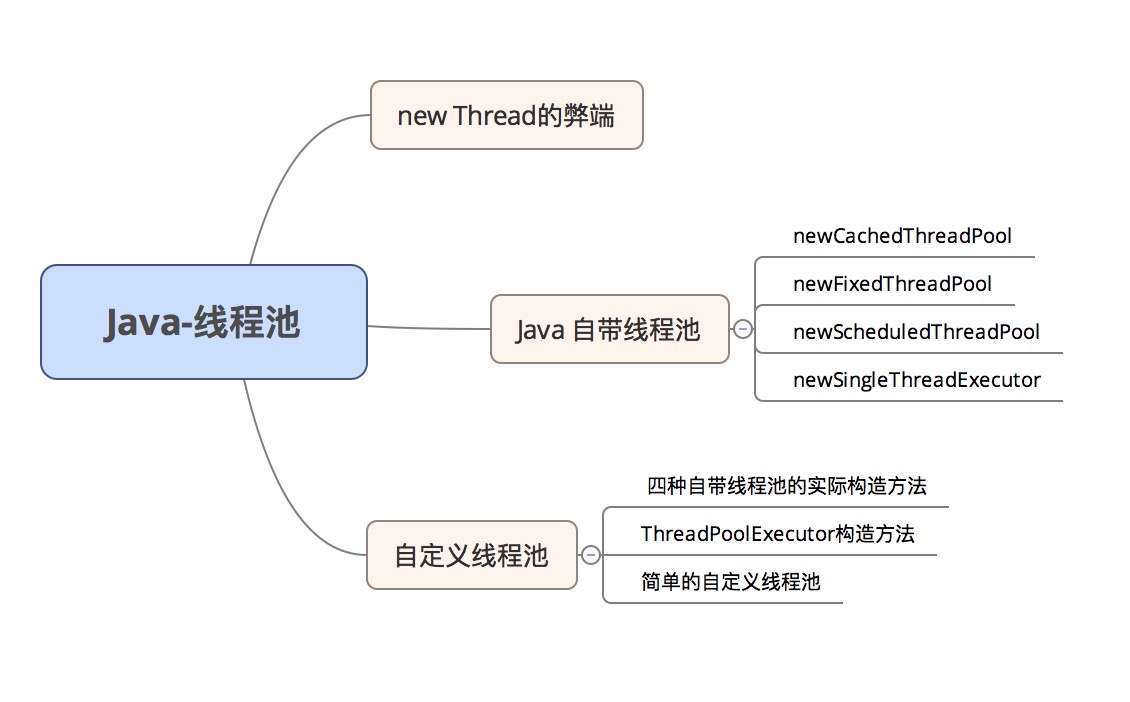1.new Thread的弊端
执行一个异步任务你还只是如下new Thread吗?
new Thread(new Runnable() {
@Override
public void run() {
// TODO Auto-generated method stub
}
}).start();那你就out太多了,new Thread的弊端如下:
- 每次new Thread新建对象性能差。
- 线程缺乏统一管理,可能无限制新建线程,相互之间竞争,及可能占用过多系统资源导致死机或oom。
- 缺乏更多功能,如定时执行、定期执行、线程中断。
相比new Thread,Java提供的四种线程池的好处在于:
- 重用存在的线程,减少对象创建、消亡的开销,性能佳。
- 可有效控制最大并发线程数,提高系统资源的使用率,同时避免过多资源竞争,避免堵塞。
- 提供定时执行、定期执行、单线程、并发数控制等功能。
2.Java 自带线程池
Java通过Executors提供四种线程池,分别为:
- newCachedThreadPool创建一个可缓存线程池,如果线程池长度超过处理需要,可灵活回收空闲线程,若无可回收,则新建线程。
- newFixedThreadPool 创建一个定长线程池,可控制线程最大并发数,超出的线程会在队列中等待。
- newScheduledThreadPool 创建一个定长线程池,支持定时及周期性任务执行。
- newSingleThreadExecutor 创建一个单线程化的线程池,它只会用唯一的工作线程来执行任务,保证所有任务按照指定顺序(FIFO, LIFO, 优先级)执行。
主要方法:
1.void execute(Runnable command):
在未来某个时间执行给定命令。该命令可能在新的线程、已入池的线程或者正调用的线程中执行,这由Executor决定。2.void shutdown():
启动一次顺序关闭,执行以前提交的任务,但不接受新任务。如果已经关闭,则调用没有其它作用。
2.1.newCachedThreadPool
创建一个可缓存的线程池。必要的时候创建新线程来处理请求,也会重用线程池中已经处于可用状态的线程。如果线程池的大小超过了处理任务所需要的线程,那么就会回收部分空闲(60秒不执行任务)的线程;当任务数增加时,此线程池又可以智能的添加新线程来处理任务。此线程池不会对线程池大小做限制,线程池大小完全依赖于操作系统(或者说JVM)能够创建的最大线程大小。
此类型线程池特别适合于耗时短,不需要考虑同步的场合。
测试代码:
/**
* 可缓存线程池
*/
private static void testCachedThreadPool() {
System.out.println("这是可缓存线程池:");
ExecutorService cachedThreadPool = Executors.newCachedThreadPool();
for (int i = 0; i < 10; i++) {
final int index = i;
try {
Thread.sleep(index * 1000);
} catch (InterruptedException e) {
e.printStackTrace();
}
cachedThreadPool.execute(new Runnable() {
@Override
public void run() {
print(index + "");
}
});
}
}输出结果:
这是可缓存线程池:
1464230153368: pool-1-thread-1: 0
1464230154372: pool-1-thread-1: 1
1464230156376: pool-1-thread-1: 2
1464230159380: pool-1-thread-1: 3
1464230163384: pool-1-thread-1: 4
1464230168386: pool-1-thread-1: 5
1464230174391: pool-1-thread-1: 6
1464230181395: pool-1-thread-1: 7
1464230189397: pool-1-thread-1: 8
1464230198400: pool-1-thread-1: 9
2.2.newFixedThreadPool
创建固定大小的线程池,以无界队列方式运行。线程池满且线程都为活动状态的时候如果有新任务提交进来,它们会等待直到有线程可用。线程池的大小一旦达到最大值就会保持不变,如果某个线程因为执行异常而结束,那么线程池会补充一个新线程。显式调用shutdown将关闭线程池。
此类型线程池比较符合常用场合。
测试代码:
/**
* 定长线程池
*/
private static void testFixedThreadPool() {
System.out.println("这是定长线程池:");
ExecutorService fixedThreadPool = Executors.newFixedThreadPool(3);
for (int i = 0; i < 10; i++) {
final int index = i;
fixedThreadPool.execute(new Runnable() {
@Override
public void run() {
try {
print(index + "");
Thread.sleep(1000);
} catch (InterruptedException e) {
// TODO Auto-generated catch block
e.printStackTrace();
}
}
});
}
}输出结果:
这是定长线程池:
1464229952132: pool-1-thread-1: 0
1464229952133: pool-1-thread-2: 1
1464229952133: pool-1-thread-3: 2
1464229953136: pool-1-thread-3: 3
1464229953136: pool-1-thread-1: 4
1464229953136: pool-1-thread-2: 5
1464229954138: pool-1-thread-1: 6
1464229954138: pool-1-thread-2: 8
1464229954138: pool-1-thread-3: 7
1464229955139: pool-1-thread-1: 9
2.3.newScheduledThreadPool
创建可定时运行(初始延时),运行频率(每隔多长时间运行,还是运行成功一次之后再隔多长时间再运行)的线程池。
此类型线程池适合定时以及周期性执行任务的场合
特别注意:
- 初始延迟2秒后,每间隔3秒运行一次线程:
schedulePool.scheduleAtFixedRate(new MyThread(), 2, 3, TimeUnit.SECONDS);- 初始延迟2秒后,每运行成功后再等3秒运行一次线程:
schedulePool.scheduleWithFixedDelay(new MyThread(), 2, 3, TimeUnit.SECONDS);
测试代码:
/**
* 周期线程池
*/
private static void testScheduledThreadPool() {
System.out.println("这是周期线程池:");
ScheduledExecutorService scheduledThreadPool = Executors.newScheduledThreadPool(5);
scheduledThreadPool.scheduleAtFixedRate(new Runnable() {
@Override
public void run() {
print("delay 3 seconds");
}
}, 2, 3, TimeUnit.SECONDS);
}输出结果:
这是周期线程池:
1464231196776: pool-1-thread-1: delay 3 seconds
1464231199776: pool-1-thread-1: delay 3 seconds
1464231202775: pool-1-thread-2: delay 3 seconds
1464231205777: pool-1-thread-1: delay 3 seconds
1464231208775: pool-1-thread-3: delay 3 seconds
1464231211775: pool-1-thread-3: delay 3 seconds
1464231214776: pool-1-thread-3: delay 3 seconds
1464231217777: pool-1-thread-3: delay 3 seconds
1464231220776: pool-1-thread-3: delay 3 seconds
2.4.newSingleThreadExecutor
创建一个单线程的线程池,以无界队列方式运行。这个线程池只有一个线程在工作(如果这个唯一的线程因为异常结束,那么会有一个新的线程来替代它。)此线程池能够保证所有任务的执行顺序按照任务的提交顺序执行,同一时段只有一个任务在运行。
此类型线程池特别适合于需要保证执行顺序的场合。
测试代码:
/**
* 单线程池
*/
private static void testSingleThreadExecutor() {
System.out.println("这是单线程池:");
ExecutorService singleThreadExecutor = Executors.newSingleThreadExecutor();
for (int i = 0; i < 10; i++) {
final int index = i;
singleThreadExecutor.execute(new Runnable() {
@Override
public void run() {
try {
print(index + "");
Thread.sleep(1000);
} catch (InterruptedException e) {
// TODO Auto-generated catch block
e.printStackTrace();
}
}
});
}
}输出结果:
这是单线程池:
1464230560509: pool-1-thread-1: 0
1464230561514: pool-1-thread-1: 1
1464230562519: pool-1-thread-1: 2
1464230563524: pool-1-thread-1: 3
1464230564529: pool-1-thread-1: 4
1464230565534: pool-1-thread-1: 5
1464230566536: pool-1-thread-1: 6
1464230567541: pool-1-thread-1: 7
1464230568546: pool-1-thread-1: 8
1464230569551: pool-1-thread-1: 9
3.自定义线程池
3.1. 四种自带线程池的实际构造方法:
1.CachedThreadPool:
public static ExecutorService newCachedThreadPool() {
return new ThreadPoolExecutor(0, Integer.MAX_VALUE,
60L, TimeUnit.SECONDS,
new SynchronousQueue<Runnable>());
}2.FixedThreadPool:
public static ExecutorService newFixedThreadPool(int nThreads) {
return new ThreadPoolExecutor(nThreads, nThreads,
0L, TimeUnit.MILLISECONDS,
new LinkedBlockingQueue<Runnable>());
}3.ScheduledThreadPool:
public static ScheduledExecutorService newScheduledThreadPool(int corePoolSize) {
return new ScheduledThreadPoolExecutor(corePoolSize);
}跳转至:
public ScheduledThreadPoolExecutor(int corePoolSize) {
super(corePoolSize, Integer.MAX_VALUE,
DEFAULT_KEEPALIVE_MILLIS, MILLISECONDS,
new DelayedWorkQueue());
}4.SingleThreadExecutor:
public static ExecutorService newSingleThreadExecutor() {
return new FinalizableDelegatedExecutorService
(new ThreadPoolExecutor(1, 1,
0L, TimeUnit.MILLISECONDS,
new LinkedBlockingQueue<Runnable>()));
}3.2.ThreadPoolExecutor构造方法:
public ThreadPoolExecutor(int corePoolSize,
int maximumPoolSize,
long keepAliveTime,
TimeUnit unit,
BlockingQueue<Runnable> workQueue,
ThreadFactory threadFactory,
RejectedExecutionHandler handler) {
if (corePoolSize < 0 ||
maximumPoolSize <= 0 ||
maximumPoolSize < corePoolSize ||
keepAliveTime < 0)
throw new IllegalArgumentException();
if (workQueue == null || threadFactory == null || handler == null)
throw new NullPointerException();
this.corePoolSize = corePoolSize;
this.maximumPoolSize = maximumPoolSize;
this.workQueue = workQueue;
this.keepAliveTime = unit.toNanos(keepAliveTime);
this.threadFactory = threadFactory;
this.handler = handler;
}参数解释:
- corePoolSize(线程池的基本大小):
当提交一个任务到线程池时,线程池会创建一个线程来执行任务,即使其他空闲的基本线程能够执行新任务也会创建线程,等到需要执行的任务数大于线程池基本大小时就不再创建。如果调用了线程池的prestartAllCoreThreads方法,线程池会提前创建并启动所有基本线程。- maximumPoolSize(线程池最大大小):
线程池允许创建的最大线程数。如果队列满了,并且已创建的线程数小于最大线程数,则线程池会再创建新的线程执行任务。值得注意的是如果使用了无界的任务队列这个参数就没什么效果。- keepAliveTime(线程活动保持时间):
线程池的工作线程空闲后,保持存活的时间。所以如果任务很多,并且每个任务执行的时间比较短,可以调大这个时间,提高线程的利用率。- unit(线程活动保持时间的单位):
可选的单位有天(DAYS),小时(HOURS),分钟(MINUTES),毫秒(MILLISECONDS),微秒(MICROSECONDS, 千分之一毫秒)和毫微秒(NANOSECONDS, 千分之一微秒)。- workQueue(任务队列):
用于保存等待执行的任务的阻塞队列。 可以选择以下几个阻塞队列。
- ArrayBlockingQueue:
是一个基于数组结构的有界阻塞队列,此队列按 FIFO(先进先出)原则对元素进行排序。- LinkedBlockingQueue:
一个基于链表结构的阻塞队列,此队列按FIFO (先进先出) 排序元素,吞吐量通常要高于ArrayBlockingQueue。静态工厂方法Executors.newFixedThreadPool()使用了这个队列。- SynchronousQueue:
一个不存储元素的阻塞队列。每个插入操作必须等到另一个线程调用移除操作,否则插入操作一直处于阻塞状态,吞吐量通常要高于LinkedBlockingQueue,静态工厂方法Executors.newCachedThreadPool使用了这个队列。- PriorityBlockingQueue:
一个具有优先级的无限阻塞队列。- threadFactory(线程工厂):
用于设置创建线程的工厂,可以通过线程工厂给每个创建出来的线程设置更有意义的名字。- handler(饱和策略):
当队列和线程池都满了,说明线程池处于饱和状态,那么必须采取一种策略处理提交的新任务。这个策略默认情况下是AbortPolicy,表示无法处理新任务时抛出异常。以下是JDK1.5提供的四种策略。
- AbortPolicy:直接抛出异常。
- CallerRunsPolicy:只用调用者所在线程来运行任务。
- DiscardOldestPolicy:丢弃队列里最近的一个任务,并执行当前任务。
- DiscardPolicy:不处理,丢弃掉。当然也可以根据应用场景需要来实现RejectedExecutionHandler接口自定义策略。如记录日志或持久化不能处理的任务。
3.3.简单的自定义线程池
核心有两个线程,最大线程数量可无限,存活时间60s
测试代码:
/**
* 自定义线程池
*/
private static void testCustomThreadPool() {
System.out.println("这是自定义线程池:");
ExecutorService customThreadExecutor = new ThreadPoolExecutor(
2, Integer.MAX_VALUE, 60L, TimeUnit.SECONDS,
new LinkedBlockingQueue<Runnable>());
for (int i = 0; i < 10; i++) {
final int index = i;
customThreadExecutor.execute(new Runnable() {
@Override
public void run() {
try {
print(index + "");
Thread.sleep(1000);
} catch (InterruptedException e) {
// TODO Auto-generated catch block
e.printStackTrace();
}
}
});
}
}输出结果:
这是自定义线程池:
1464235380782: pool-1-thread-1: 0
1464235380783: pool-1-thread-2: 1
1464235381787: pool-1-thread-2: 2
1464235381787: pool-1-thread-1: 3
1464235382790: pool-1-thread-2: 5
1464235382790: pool-1-thread-1: 4
1464235383793: pool-1-thread-1: 7
1464235383793: pool-1-thread-2: 6
1464235384798: pool-1-thread-1: 8
1464235384798: pool-1-thread-2: 9
参考目录:
1. Java:多线程,线程池,用Executors静态工厂生成常用线程池
2. Java(Android)线程池























 9371
9371

 被折叠的 条评论
为什么被折叠?
被折叠的 条评论
为什么被折叠?








